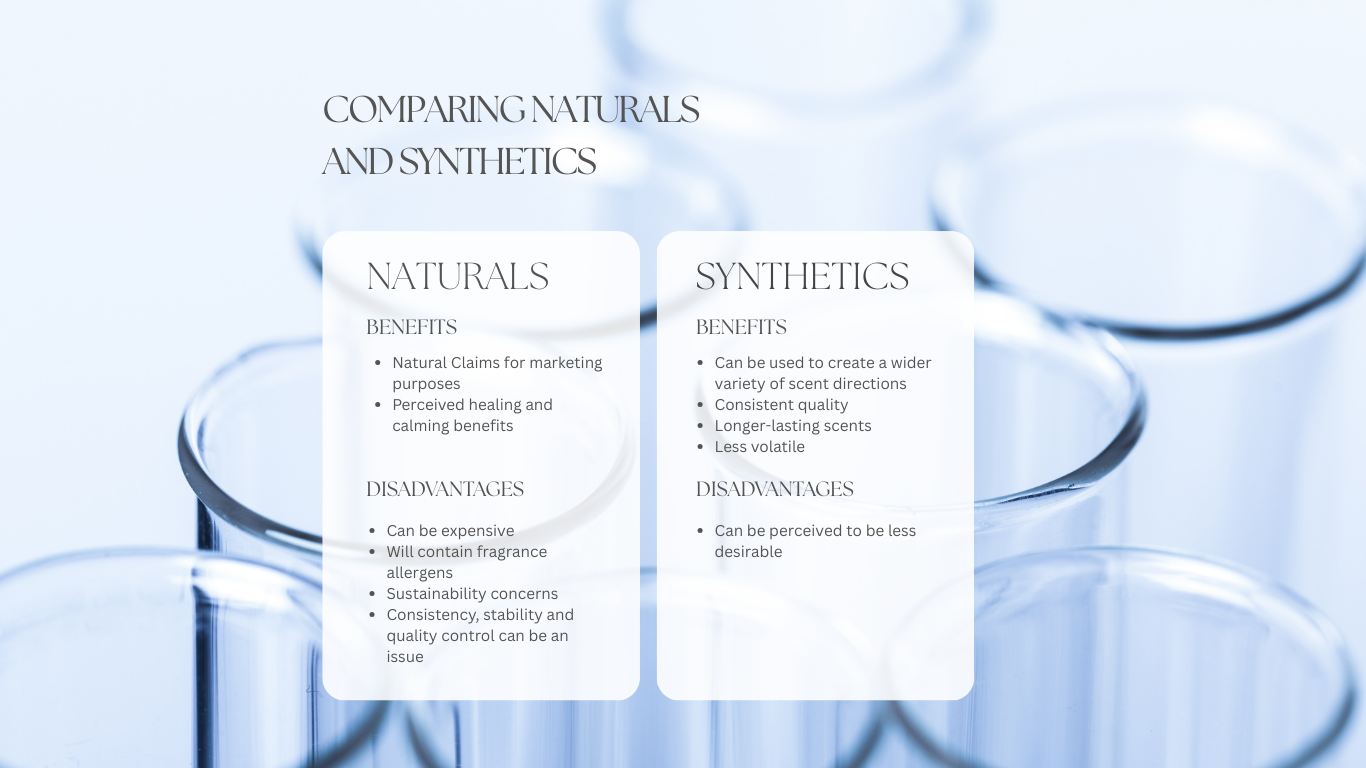Fragrance selection can be a confusing and complex world, especially when we start to look at the debate between natural and synthetic fragrance. There are many misconceptions around the choice between these two types of fragrance. This guide seeks to demystify the debate between synthetics and naturals and support you in finding the best options for your product.
NATURAL FRAGRANCES
WHAT IS A NATURAL FRAGRANCE?
Natural fragrances are composed from aromatic materials which have been physically obtained from natural sources by either distillation, extraction or expression. According to ISO 9235:2013, a “natural” fragrance must be composed solely of natural raw materials. Many of these materials will be commonly referred to as Essential Oils, such as Lavender Oil or Absolutes (derived from solvent extraction) such as Rose Absolute.

THE CHALLENGES OF USING A NATURAL FRAGRANCE
Although natural extractions are seen as eco-friendly with additional health benefits there are limitations. A natural material will contain within its structure multiple chemicals, some of which are classed as allergens or can cause harm in alternative ways and therefore have restrictions placed on them by the industry.
Sustainability is also a concern, as demand increases there is an increase in deforestation, which has a negative toll on the environment.
Additionally, natural materials are affected by changes to the climate which can cause availability issues, meaning supply and cost prices can be unstable.
Importantly, although there are naturals we fall in love with, and are almost a perfume in their own right, the industry demands fragrances to live up to expectations of consistency, quality, strength and performance which unfortunately is of greater difficulty using only naturals.
SYNTHETIC FRAGRANCES
WHAT IS A SYNTHETIC FRAGRANCE?
The International Organization for Standardization (ISO) does not have a specific standard defining “synthetic fragrance, but the recognised definition of synethic fragrance is one which contains aromatic materials which are created from chemical processes in a lab that aim to replicate the smells we encounter in nature.
Synthetics can be derived from varied sources and therefore differentiated into the different groups below:
Natural isolates
These materials are extracted from additional processes carried out on natural raw materials. i.e. Citral from Lemongrass Oil
Non-natural synthetics
Produced from chemical processes to create a material which is not found in nature, for example Iso E Super / Ethyl Maltol
Nature-identical synthetics
These are synthesised from chemicals to obtain a material with an identical chemical structure to those found in naturally. i.e. Eugenol > Vanillin
DID YOU KNOW?
Synthetic does not necessarily mean artificial, indeed, the industry is progressing to use new processes, biochemistry / green chemistry to produce new aroma chemicals (biosynthetics) which are considered more sustainable.
THE BENEFITS OF SYNTHETIC FRAGRANCE MATERIALS
Using synthetic materials often has the benefit of consistent quality along with a scent that can be richer, longer lasting and more intense than essential oils. Easily mass produced and with a greater shelf life in comparison to naturals, the availability and cost implications of synthetic materials are generally less volatile.
As has been the case over the years, synthetics are often created to replace naturals which aren’t as readily available anymore, especially when we look at the past use of animal sources, such as musks, which are now banned in the industry.
For the perfumer, there is a vast amount of synthetics being produced in the industry when compared to naturals, this allows a much wider palette in which to create unique compositions, with additional benefits of greater stability in various media, which generally makes them easier to work with. Without the use of synthetics, a perfumers ability to create varied, interesting, stable perfumes is severely restricted.

Synthetics allow perfumers a broader palette to craft unique, stable, and high-performing fragrances. They’ve also helped replace rare and ethically problematic natural sources like animal musks. Without synthetics, the creativity, variety and reliability of many fragrances would be much more limited.
But if naturals are a key focus for your business, we are happy to support you with your requirements.
At Carvansons, we blend the best science and artistry to deliver high-quality fragrances that meet every preference. Whether natural or synthetic, we choose ingredients based on performance, sustainability, and your needs. Because in fragrance creation, balance and innovation are everything.
For more information about our approach and process, please email hello@carvansons.co.uk
